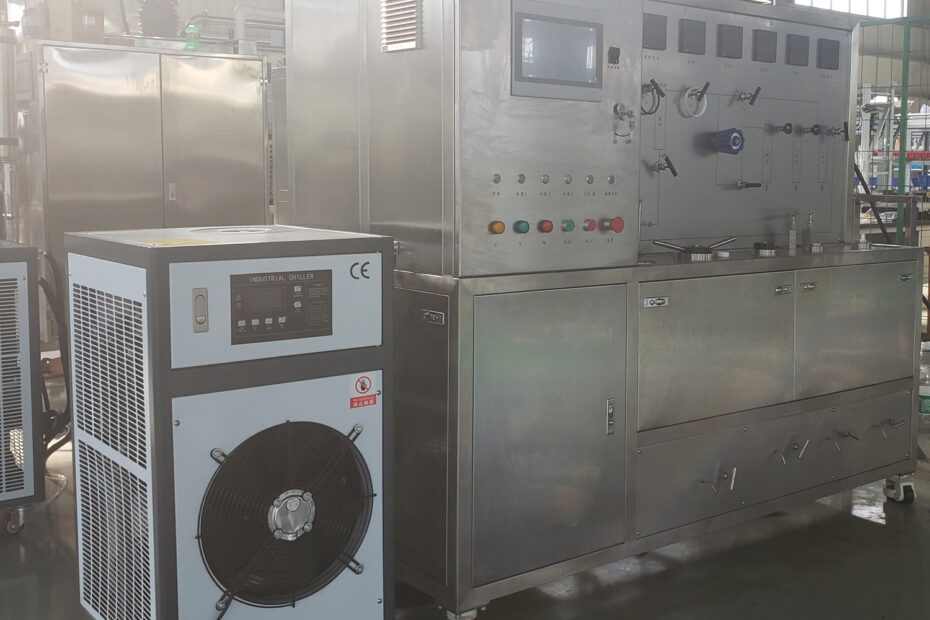The landscape of extraction technologies has evolved, and among the frontrunners is the Supercritical CO₂ extraction process. This innovative method goes beyond conventional approaches, offering a dynamic solution for separating and extracting specific substances from both solid and liquid media.
At the heart of this process is the use of carbon dioxide in a supercritical state—a phase where it exhibits both liquid and gas properties. This unique state allows CO₂ to act as a powerful solvent, providing a versatile platform for extraction across various industries.
Supercritical CO₂ fluid extraction technology is an emerging extraction and separation technology in the food industry. Compared with the traditional organic reagent method, the products produced using supercritical CO₂ fluid extraction technology have no solvent residue and pollution, which can avoid the extraction of the extract at high temperatures.
Single-stage supercritical CO₂ fluid extraction process
The process flow of supercritical CO₂ fluid extraction is set up according to different extraction objects and to complete different extraction purposes.
One extract, one type
The single-stage supercritical CO₂ fluid extraction process mainly uses an extraction kettle and a separation kettle as the main extraction and separation devices to achieve the purpose of extraction. It is the earliest and most commonly used process. It uses a full contact between the supercritical fluid and the separation system, uses the fluid’s dissolution selectivity of the components to take the components dissolved in the fluid out of the extraction kettle, and then changes the operating parameters to make the components in the fluid Precipitated in the separation kettle. This process is an isothermal or isobaric process, which is suitable for extracting plant essential oils, oils and small molecular substances. There is no need to separate after extraction, and the mixed component product can be obtained by direct analysis. The basic process flow is shown in Figure 2-2.
The entire supercritical CO₂ fluid extraction device mainly consists of CO₂ cylinders, purifiers, thermostatic devices, high-pressure pumps, extraction kettles, and separation kettles. The extraction mainly involves four systems: refrigeration system, heating system, pressurization system, and purification system. The entire fluid extraction and separation process is divided into the following stages.
- Preliminary stage of extraction: routine safety inspection, material pretreatment, material barrel filling and preheating in the extraction kettle, refrigeration and liquefaction of CO₂, and constant temperature preheating of the extraction kettle and separation kettle.
- In the extraction pressure preparation stage, liquid CO₂ is injected into the extraction kettle through a high-pressure pump, and the throttle valve is used to adjust the pressure of the extraction kettle to predetermined parameters; the fluid from the extraction kettle is input into the separation kettle, and the throttle valve is used to adjust the pressure of the separation kettle to experimental parameters; parameters If the requirements are met, cycle extraction is performed.
- Extraction operation stage: record the time, adjust the pressure, keep the temperature of the extraction kettle and separation kettle consistent with the experimental parameters, and collect the extract.
- Extraction clean-up stage: reduce pressure to recover CO₂ and recover the raffinate materials.
- Later data processing stage: perform data processing and analysis based on the extraction results, and improve the extraction process.
Since the single-stage supercritical CO₂ fluid extraction process has only one extraction kettle, and the raffinate cannot be extracted under high pressure, the extraction kettle needs to be depressurized after the extraction is completed, and the extraction kettle can be refilled with new materials after the extraction raffinate is taken out. Therefore, the extraction process It’s intermittent. This process was widely used in early production and laboratories. It has problems such as difficulty in controlling the extraction process and high extraction costs. It requires a more scientific design to achieve continuous extraction.

Two extracts and one part or multiple extracts and one part
Early supercritical CO₂ extraction processes mostly used an intermittent single-stage, one-extraction, one-minute extraction process. For industrial production, intermittent production is difficult to meet the requirements. It not only needs to reduce production costs, but also needs to improve production efficiency. Based on the single-stage, one-extraction, one-part extraction process, scientific researchers have designed a two-extraction, one-part extraction process. Or multi-extraction and one-part extraction equipment. At present, this type of process has been applied in many experimental studies, and its simple process is shown in Figure 2-3.
The single-stage two-extraction one-part or two-extraction multi-part extraction process is essentially an intermittent extraction process, and its continuous extraction process is achieved through the alternate operation of two or more extraction kettles. For a single kettle, the extraction process is intermittent, but the entire extraction process is continuous. During operation of this combination of multiple extraction kettles, after the extraction of the materials in one extraction kettle is completed, the passage is closed, and then another extraction kettle is opened to continue the new extraction operation; at the same time, the extraction kettle that is not in production can release the pressure and take out the extraction. Remaining materials, add new materials. Although this process is theoretically closer to continuous production, there are also some problems in actual production, such as CO₂ loss, metal fatigue caused by frequent opening of high-voltage equipment, frequent material unloading and filling, etc., which restrict this type of supercritical Application of CO₂ fluid extraction process in industrial production.
Conclusion
The supercritical CO₂ extraction process stands as a versatile and sustainable solution for separating and extracting substances from solid and liquid media. Its precision, environmental friendliness, and adaptability make it a preferred choice across industries, from pharmaceuticals to culinary arts. As technology continues to advance, the role of supercritical CO₂ extraction is likely to expand, unlocking new possibilities for substance separation and purification.
